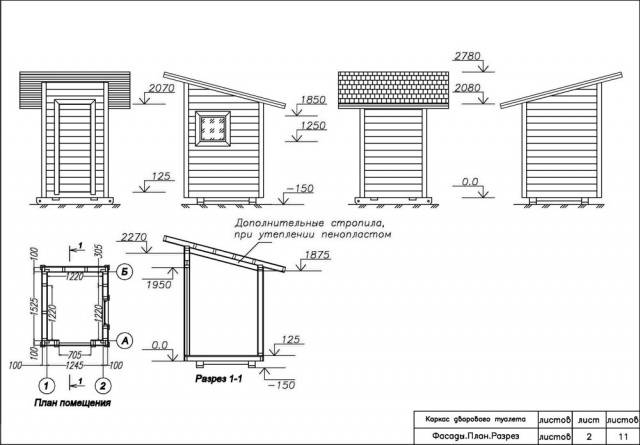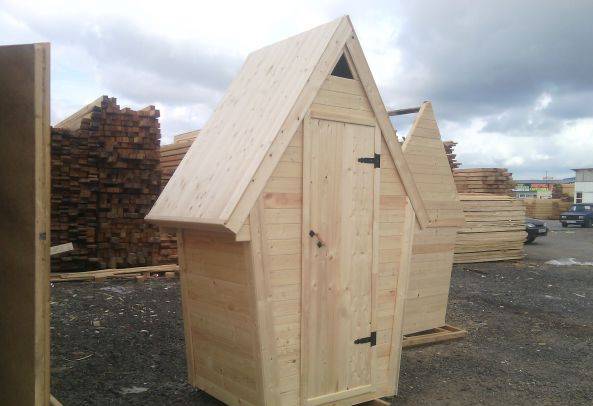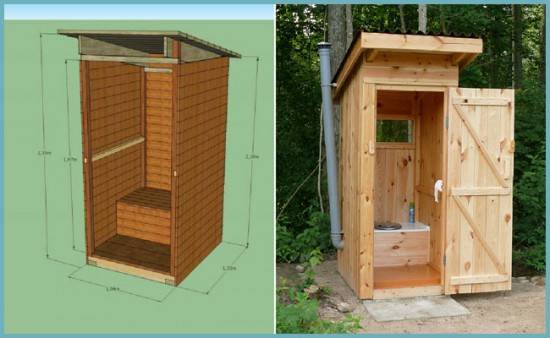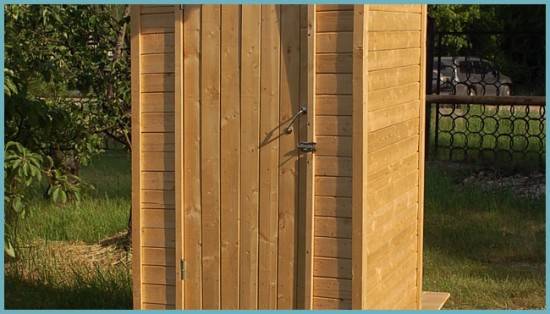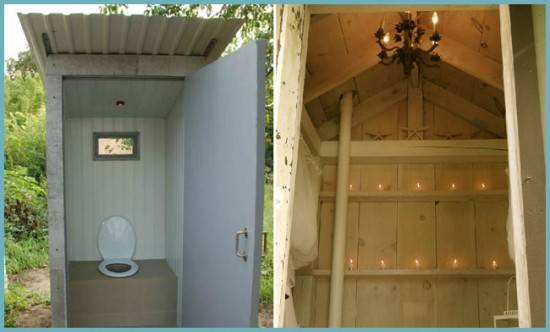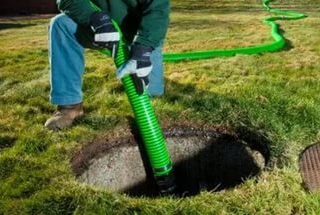Content
The arrangement of any summer cottage begins with the construction of an outdoor toilet. This simplest construction is in high demand, even if the house already has a bathroom. Anyone can build a toilet for a summer house. To do this, you need to have a simple drawing, a few inexpensive tools and building materials on hand.
What types of outdoor toilets are there?
If we give the design a general overview, then the outdoor toilet can be with or without a cesspool for accumulating waste. You can independently build a toilet with the following design on your summer cottage:
- The design of the simplest toilet consists of a cubicle, under which there is a waste storage tank. If the cesspool is designed for a large number of users, its walls are built solid, for example, from brick or concrete.As the reservoir of the country toilet is filled with sewage, it is pumped out using a sewer truck. If the toilet is rarely used, the storage tank is made shallow. After it is filled, the toilet house is moved to another place, and the old pit is preserved. The photo shows an example of a diagram of a country toilet with a cesspool.
- Toilet backlash-closet represents the same country toilet with a cesspool that can be seen in the photo. The difference in the design is the storage tank itself. The shape of the cesspool from the place where the toilet seat is installed to the general storage tank is increasing. Moreover, the bottom of the tank is made at a slope. This allows waste to move by gravity to a common storage facility. The cesspool of a country backlash closet is made sealed and insulated. You can use such a system in an outdoor toilet for a summer residence or a bathroom inside the house. It is advisable to build a backlash closet indoors at the initial stage of construction of a country house, since the load-bearing wall of the building is at risk.
- The simplest country toilet is considered to be a powder closet.. Its design does not involve digging a cesspool. This is a kind of dry closet. Waste is collected in a small container installed under the toilet seat. Moreover, after each visit to the toilet, the feces are sprinkled with peat. To do this, a separate bucket with powder and a scoop are installed in the house. The store-bought powder closet is equipped with an additional peat tank and a distribution mechanism. After visiting the toilet, it is enough to turn the handle of the mechanism, and the peat will automatically be scattered across the entire bottom of the storage tank. After filling the container with waste, they are thrown into a compost pit, where good fertilizer is obtained for the garden.Such a toilet for a dacha is suitable if it is rarely visited by people. An example of a country powder-closet system can be seen in the photo.
Before you start building a toilet in your dacha with your own hands, it is important to determine the depth of the groundwater. The choice of design will depend on this. A toilet with a cesspool is suitable for a summer cottage where the layers of groundwater are located deeper than 2.5 m. In all other cases, you will have to be content with a powder closet or bury a solid plastic barrel in the ground.
Choosing a place for a country toilet
Despite the simplicity of the design, a toilet built in a dacha should not cause discomfort to neighbors, nor serve as a source of soil and water contamination. Choose a place for an outdoor toilet, guided by sanitary rules that require maintaining distance:
- to any water sources – 25 m;
- to basements, residential buildings - 12 m;
- to a bathhouse or summer shower - 8 m;
- to the neighbor’s boundary line or fence – 1 m;
- to shrubs – 1 m;
- to fruit trees - 4 m.
It is advisable to choose a place for a country house building taking into account the landscape of the site and the wind rose. In hilly areas, the outdoor toilet is placed in the lowest place. It is important that the wind carries away bad odors in the opposite direction from your own and neighboring residential buildings.
The construction of a country toilet begins with a cesspool
Under the street toilet, in addition to the powder closet, it is necessary to dig a cesspool. There are many options for arranging a tank. If we are considering how to build a toilet in a country house from start to finish, then we need to start with the cesspool.
Determining the size of the cesspool for a country toilet
Before digging a pit, the first question that arises is how to correctly determine its dimensions. Let's immediately focus on the depth, which should not exceed 3 m. The size of the side walls of the tank depends on the number of people living. If there is enough building material, the cesspool can be made large. Then you will have to pump it out less often. Usually, a cesspool 2 m deep is dug for a simple street toilet, and the width of the walls is made from 1 to 1.5 m.
If sewage from the house is connected to the cesspool, the volume of wastewater per month for each person living in the dacha is taken into account. For example, a family of three will use approximately 12 m3 per month.3 water. The cesspool is made with a reserve, so a volume of up to 18 m is desirable3.
Features of the construction of a cesspool
A cesspool for an outdoor toilet in a country house is built from all kinds of materials available on the farm. Red brick, cinder block, concrete rings, plastic and metal containers, and old car tires are used. The cheapest, most reliable and easiest to construct is a brick pit. It may or may not be sealed. In the first case, the bottom is concreted up to 15 cm thick. The lined walls are plastered with concrete, and the top is treated with bitumen mastic.
If the soil at the dacha has good absorbent properties, the cesspool is made leaky. The bottom of the storage tank is covered with a 15 cm layer of sand and crushed stone. This creates a drainage through which the liquid will be absorbed into the ground. The brickwork of the walls for a leaky pit is done in a checkerboard pattern.Through the resulting windows between the bricks, the liquid will additionally be absorbed into the soil.
The top of the cesspool is covered with a concrete slab with a hatch for maintenance, as well as a hole for a toilet seat. If there is no concrete slab, the tank is covered with tin, a reinforcing mesh is laid, and then filled with concrete. It turns out to be a homemade reinforced concrete slab.
Cesspool made of reinforced concrete rings
The most reliable is a pit made of concrete rings. The made tank can last at the dacha for up to 100 years. The difficulty of construction lies only in the fact that lifting equipment is required to immerse the rings in the pit.
So, taking half a meter of reserve from the diameter of the reinforced concrete ring, they dig a pit. The bottom is concreted in the same way as for a brick cesspool. If you managed to buy a concrete ring with a finished bottom, then it is installed directly into the pit. Before doing this, it is advisable to add a 10 cm layer of sand underneath. The following rings are installed on top of each other. If there are connecting locks at the ends of reinforced concrete products, it is enough to get into the grooves during installation. In the absence of locks, the connections of the rings are made using concrete mortar for tightness, and they are fastened together with metal rings.
The finished cesspool is treated with bitumen for waterproofing, and covered with a concrete slab on top.
Cesspool made from a plastic container
If building a toilet in a country house is impossible due to groundwater, a plastic container will come to the rescue. A pit is dug slightly larger than the dimensions of the tank. Work on such a site is carried out during a period when groundwater is low.The bottom of the plastic container must be concreted, and 4 metal loops are attached to the reinforcing mesh. They should protrude from the concrete in height so that a plastic tank can be tied to the hinges. This is done so that when groundwater rises, it does not push the light container out of the ground like a float.
After the concrete has hardened, the plastic tank is installed in the pit. The container is tied to the loops with cables. Backfilling is carried out simultaneously with filling the tank with water, otherwise soil pressure will compress its walls. It is better to fill the gap between the walls of the container and the pit with a dry mixture of five parts sand and one part cement. When the tank is completely filled, water is pumped out of it using any pump.
The video talks about the cesspool:
The order of work during the construction of a country toilet house
When building a toilet for a summer house with your own hands, step-by-step instructions will help you decide on the order of work. From the very beginning, it is important to draw up a diagram of the house, where its shape will be drawn and all dimensions will be indicated. You can make the drawings at your own discretion or find ready-made ones on the Internet. The optimal size of a toilet in a country house is considered to be: width of the house - 1 m, depth - 1.5 m, height from 2 to 2.5 m.
As an example, we suggest looking at the drawings of the dimensions of the toilet in the country with your own hands, which will help you determine the dimensions of the street house.
The simplest and most common version of an outdoor toilet house is a birdhouse. The photo shows the finished structure, a table of consumables, as well as the structure diagram itself.
The next photo shows a model of an outdoor toilet house in the form of a hut, no less popular for dachas.
Making the base of a wooden house
We begin building a toilet for a summer residence by preparing the foundation. A wooden house is lightweight, so it can be supported by a simple foundation. It is important to take into account that at the back of the building you will need to make an opening hatch for cleaning the cesspool and arranging ventilation. It is optimal to move the house 2/3 relative to the storage tank.
Having made markings on the ground according to the dimensions of the future house, we proceed to making the base. Under a light wooden structure, it is enough to place four concrete blocks in the corners. If it is planned to manufacture a metal frame of the house for sheathing with corrugated sheets, the foundation can be made from pieces of asbestos pipes 1 m long dug vertically. Fill the internal cavity of the pipe with concrete. We lay waterproofing from pieces of roofing felt on the finished base.
Assembling the frame of a wooden house
So, the foundation is ready, it’s time to build a toilet in the country house with your own hands according to these instructions:
- We begin the work by making a support with right angles. We knock down the frame of the house from timber with a section of 80x80 mm. We install a jumper approximately in the center of the side bars along the frame. The front wall of the toilet seat will be attached to it. We fix the finished frame to the concrete base with anchor bolts.
- We fill the floor from a 3 cm thick board on a frame. It is important not to forget to leave a hatch under the toilet seat.
- Next, we build a toilet from timber with a section of 50x50 mm. That is, you must first build the frame of the house. We fix the side wall posts to the already made support with the floor. Moreover, the elements of the front wall should be 10 cm higher than the rear pillars.This will make it possible to give the roof of the country toilet a slope.
- We install jibs diagonally between the racks on each wall of the toilet. These spacers will give strength to the frame. We install two additional door posts at the front. The distance between them is enough 60 cm. Above the future doors, we attach a cross member to the posts, which forms the frame of the house window. Reliable fastening of the house frame posts is ensured by metal overhead corners.
- When the entire frame of the house is ready, we assemble the frame of the toilet seat from the timber. An example of the design is shown in the photo. We cover the finished toilet seat with a board along the frame.
With this the skeleton of the future outdoor toilet house for the dacha is ready, it’s time to start cladding.
We cover the frame of the country toilet with boards
Facing the house should not create big problems. We cut the boards to the size of the back and side walls, fit them tightly together and nail them. Depending on the length of the workpieces, they can be attached to the frame vertically or horizontally. Alternatively, the board can be replaced with corrugated board or other sheet material.
Roof and ventilation installation
For the roof, we nail a lathing from a board onto the top frame of the house frame. It is enough to provide an outlet of 30 cm outside the box so that the rain does not wet the walls of the toilet. We fix any sheet of roofing material to the sheathing. Corrugated sheeting, metal tiles or regular slate are suitable.
We fix the ventilation pipe with metal strips to the rear wall of the toilet. The air duct is made from a plastic pipe 100 mm thick.We immerse the lower part of the riser under the lid into the cesspool to a depth of 10 cm. We extend the top of the air duct above the roof of the toilet 20 cm higher.
Installation of the door and supply of lighting inside the house
The door for the house can be knocked down from a regular board, buy a plastic one, or make a frame and cover it with corrugated board. We attach it to the vertical posts using hinges. We screw the handles on both sides and the latch from the inside onto the door using self-tapping screws. To prevent the door from opening arbitrarily, the latch can be additionally placed outside.
If there is a point not far from the country toilet where you can connect an electric cable, it is advisable to install lighting inside the house. This will give comfort during night use. During the day, it will be light in the country toilet thanks to the window above the doors.
The video shows how the toilet is made:
Conclusion
That's all the general recommendations on how to make a toilet in the country with your own hands using simple drawings.













